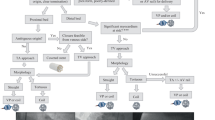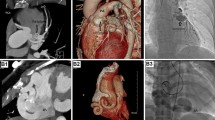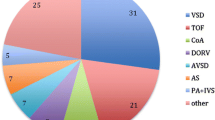Abstract
Purpose of Review
Coronary artery fistulas (CAFs) are rare coronary anomalies that most often occur as congenital malformations in children. Although most children with CAFs are asymptomatic at the time of diagnosis, some present with symptoms of congestive heart failure in the setting of large left-to-right shunts. Others may develop additional complications including coronary artery ectasia and coronary thrombosis. Surgical and transcatheter closure techniques have been previously described. This review presents the classifications of CAFs in children and the short and long-term outcomes of CAF closure in children in the reported literature. We also summarize previously-reported angiographic findings and post-treatment remodeling characteristics in pediatric patients.
Recent Findings
With advancements in cross-sectional imaging technologies, anatomic delineation of CAFs via these modalities has become crucial in procedural planning. Recent reports of surgical and transcatheter closure of CAFs in children have reported good procedural success and low rates of short-term morbidity and mortality. Distal-type CAFs have elevated risk for long-term sequelae post-closure compared to proximal-type CAFs. A recent report of a multi-institutional cohort also describes post-closure remodeling classifications which may predict long-term outcomes in these patients as well as guide individualized anticoagulation management.
Summary
Invasive closure of significant CAFs via surgical or transcatheter techniques is feasible and safe in most children with good short and intermediate-term outcomes. However, close clinical and imaging follow-up is required to monitor for late complications even after successful closure. Antiplatelet and anticoagulation regimens remain important aspects of post-closure management, but the necessary intensity and duration of such therapy remains unknown.









Similar content being viewed by others
References
Papers of particular interest, published recently, have been highlighted as: • Of importance •• Of major importance
Loukas M, Germain AS, Gabriel A, John A, Tubbs RS, Spicer D. Coronary artery fistula: a review. Cardiovasc Pathol. 2015;24:141–8.
Yamanaka O, Hobbs RE. Coronary artery anomalies in 126,595 patients undergoing coronary arteriography. Cathet Cardiovasc Diagn. 1990;21:28–40.
McNamara JJ, Gross RE. Congenital coronary artery fistula. Surgery. 1969;65:59–69.
Said SM, Burkhart HM, Schaff HV, Connolly HM, Phillips SD, Suri RM, et al. Late outcome of repair of congenital coronary artery fistulas - a word of caution. J Thorac Cardiovasc Surg. 2013;145:455–60.
Liberthson RR, Sagar K, Berkoben JP, Weintraub RM, Levine FH. Congenital coronary arteriovenous fistula report of 13 patients, review of the literature and delineation of management. Circulation [Internet]. 1979;59:849–54. Available from: http://ahajournals.org.
Sherwood MC, Rockenmacher S, Colan SD, Geva T. prognostic significance of clinically silent coronary artery fistulas. Am J Cardiol. 1999;83:407–11.
Burch GH, Sahn DJ. Congenital coronary artery anomalies: the pediatric perspective. Coron Artery Dis [Internet]. 2001;12:605–16. Available from: http://journals.lww.com/coronary-artery.
Sakakibara S, Yokoyama M, Takao A, Nogi M, Gomi H. Coronary arteriovenous fistula Nine operated cases. Am Heart J. 1966;307–14.
Latson LA. Coronary artery fistulas: How to manage them. Catheterization and Cardiovascular Interventions. Wiley-Liss Inc.; 2007. p. 111–8.
•• Gowda ST, Latson L, Sivakumar K, Hiremath G, Crystal M, Law M, et al. Anatomical classification and posttreatment remodeling characteristics to guide management and follow-up of neonates and infants with coronary artery fistula: a multicenter study from the Coronary Artery Fistula Registry. Circ Cardiovasc Interv. 2021;14:E009750. This study presents multicenter outcomes data in children after CAF closure. The authors describe a post-closure remodeling classification system which may correlate with risk for long-term complications after invasive management of CAFs.
Reddy G, Davies JE, Holmes DR, Schaff HV, Singh SP, Alli OO. Coronary artery fistulae. Circ Cardiovasc Interv: Lippincott Williams and Wilkins; 2015.
Kamiya H, Yasuda T, Nagamine H, Sakakibara N, Nishida S, Kawasuji M, et al. Surgical treatment of congenital coronary artery fistulas: 27 Years’ experience and a review of the literature. J Card Surg. 2002;17:173–7.
Vinograd CA, Ostermayer S, Lytrivi ID, Ko HH, Parness I, Geiger M, et al. Prevalence and outcomes of coronary artery ectasia associated with isolated congenital coronary artery fistula. Am J Cardiol. 2014;114:111–6.
Pisesky A, Nield LE, Rosenthal J, Jaeggi ET, Hornberger LK. Comparison of pre- and postnatally diagnosed coronary artery fistulae: echocardiographic features and clinical outcomes. J Am Soc Echocardiogr. 2022;35:1322–35.
• Al-Hijji M, El Sabbagh A, El Hajj S, AlKhouli M, El Sabawi B, Cabalka A, et al. Coronary artery fistulas: indications, techniques, outcomes, and complications of transcatheter fistula closure. JACC Cardiovasc Interv. 2021;14:1393–406. This report describes a decision-making algorithm for the transcatheter closure of CAFs, closure techniques, and a summary of recent reported outcomes of transcatheter fistula closure.
Velasco Forte MN, Byrne N, Valverde Perez I, Bell A, Gómez-Ciriza G, Krasemann T, et al. 3D printed models in patients with coronary artery fistulae: anatomical assessment and interventional planning. EuroIntervention. 2017;13:e1080–3.
Arar Y, Hussain T, Abou Zahr R, Gooty V, Greer JS, Huang R, et al. Fick versus flow: a real-time invasive cardiovascular magnetic resonance (iCMR) reproducibility study. J Cardiovasc Magn Reson. 2021;23:95.
Tangcharoen T, Bell A, Hegde S, Hussain T, Beerbaum P, Schaeffter T, et al. Detection of coronary artery anomalies in infants and young children with congenital heart disease by using MR imaging. Radiology. 2011;259:240–7.
Detorakis EE, Foukarakis E, Karavolias G, Dermitzakis A. Cardiovascular magnetic resonance and computed tomography in the evaluation of aneurysmal coronary-cameral fistula. J Radiol Case Rep. 2015;9:10–21.
Christmann M, Hoop R, Dave H, Quandt D, Knirsch W, Kretschmar O. Closure of coronary artery fistula in childhood: treatment techniques and long-term follow-up. Clin Res Cardiol. 2017;106:211–8.
Gowda ST, Forbes TJ, Singh H, Kovach JA, Prieto L, Latson LA, et al. Remodeling and thrombosis following closure of coronary artery fistula with review of management: large distal coronary artery fistula - To close or not to close? Catheter Cardiovasc Interv. 2013;82:132–42.
Yun G, Nam TH, Chun EJ. Coronary artery fistulas: pathophysiology, imaging findings, and management. Radiographics. 2018;38:688–703.
Ito H, Kamiyama T, Nakamura W, Segawa K, Takahashi K, Iijima T, et al. Coronary artery-pulmonary artery fistula originating from three major coronary branches associated with exertional chest pain and tachycardia-dependent left bundle branch block. Jpn Heart J. 1998;39:247–53.
Chiu C-Z, Shyu K-G, Cheng J-J, Ling S-C, Lee S-H, Hung H-F, et al. Angiographic and clinical manifestations of coronary fistulas in chinese people- 15-year experience. Circ J. 2008;72:1242–8.
Nagpal P, Khandelwal A, Saboo SS, Garg G, Steigner ML. Symptomatic coronary cameral fistula Heart Views. 2015;16:65–7.
Welisch E, Norozi K, Burrill L, Rauch R. Small coronary artery fistulae in childhood: a 6-year experience of 31 cases in a tertiary paediatric cardiac centre. Cardiol Young. 2016;26:738–42.
Valente AM, Lock JE, Gauvreau K, Rodriguez-Huertas E, Joyce C, Armsby L, et al. Predictors of long-term adverse outcomes in patients with congenital coronary artery fistulae. Circ Cardiovasc Interv. 2010;3:134–9.
Armsby LR, Keane JF, Sherwood MC, Forbess JM, Perry SB, Lock JE. Management of coronary artery fistulae patient selection and results of transcatheter closure. J Am Coll Cardiol. 2002;39:1026–32.
Hou B, Ma WG, Zhang J, Du M, Sun HS, Xu JP, et al. Surgical management of left circumflex coronary artery fistula: A 25-year single-center experience in 29 patients. Ann Thorac Surg. 2014;97:530–6.
Cheng TO. Management of coronary artery fistulas: Percutaneous transcatheter embolization versus surgical closure. Catheterization and Cardiovascular Interventions. Wiley-Liss Inc.; 1999. p. 151–2.
Vaidya YP, Green GR. Coronary artery fistula. J Card Surg. Blackwell Publishing Inc.; 2019. p. 1608–16.
Said SAM, Lam J, van der Werf T. Solitary coronary artery fistulas: a congenital anomaly in children and adults. A contemporary review. Congenit Heart Dis. 2006. p. 63–76.
Zhang W, Hu R, Zhang L, Zhu H, Zhang H. Outcomes of surgical repair of pediatric coronary artery fistulas. J Thorac Cardiovasc Surg. 2016;152:1123-1130.e1.
Thakkar B, Patel N, Poptani V, Madan T, Saluja T, Shukla A, et al. Clinical and angiographic follow-up of coronary artery fistula interventions in children: techniques and classification revisited. Cardiol Young. 2015;25:670–80.
Gowda ST, Latson LA, Kutty S, Prieto LR. Intermediate to long-term outcome following congenital coronary artery fistulae closure with focus on thrombus formation. Am J Cardiol. 2011;107:302–8.
Hsieh KS, Huang TC, Lee CL. Coronary artery fistulas in neonates, infants, and children: Clinical findings and outcome. Pediatr Cardiol. 2002;23:415–9.
Arnett DK, Blumenthal RS, Albert MA, Buroker AB, Goldberger ZD, Hahn EJ, et al. 2019 ACC/AHA Guideline on the primary prevention of cardiovascular disease: a report of the American College of Cardiology/American Heart Association Task Force on Clinical Practice Guidelines. Circulation. NLM (Medline); 2019. p. e596–646.
Expert Panel on Integrated Guidelines for Cardiovascular Health and Risk Reduction in Children and Adolescents, National Heart L and BI. Expert panel on integrated guidelines for cardiovascular health and risk reduction in children and adolescents: summary report. Pediatrics. 2011;128 Suppl 5:S213–56.
Flynn JT, Kaelber DC, Baker-Smith CM, Blowey D, Carroll AE, Daniels SR, et al. Clinical practice guideline for screening and management of high blood pressure in children and adolescents. Pediatrics. 2017;140.
Stewart J, McCallin T, Martinez J, Chacko S, Yusuf S. Hyperlipidemia. Pediatr Rev. 2020;41:393–402.
Grundy SM, Stone NJ, Bailey AL, Beam C, Birtcher KK, Blumenthal RS, et al. 2018 AHA/ACC/AACVPR/AAPA/ABC/ACPM/ADA/AGS/APhA/ASPC/NLA/PCNA Guideline on the management of blood cholesterol: executive summary: a report of the American College of Cardiology/American Heart Association Task Force on Clinical Practice Guidelines. Circulation. 2019;139:e1046–81.
Ethics declarations
Conflict of Interest
The authors declare no competing interests.
Human and Animal Rights and Informed Consent
This article does not contain any studies with human or animal subjects performed by any of the authors.
Additional information
Publisher's Note
Springer Nature remains neutral with regard to jurisdictional claims in published maps and institutional affiliations.
Rights and permissions
Springer Nature or its licensor (e.g. a society or other partner) holds exclusive rights to this article under a publishing agreement with the author(s) or other rightsholder(s); author self-archiving of the accepted manuscript version of this article is solely governed by the terms of such publishing agreement and applicable law.
About this article
Cite this article
Wu, S., Fares, M., Zellers, T.M. et al. Diagnosis and Management of Congenital Coronary Artery Fistulas in Infants and Children. Curr Cardiol Rep 25, 1921–1932 (2023). https://doi.org/10.1007/s11886-023-02007-0
Accepted:
Published:
Issue Date:
DOI: https://doi.org/10.1007/s11886-023-02007-0




